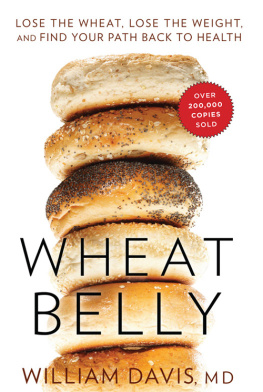
Living Wheat-Free For Dummies
Published by: John Wiley & Sons, Inc., 111 River Street, Hoboken, NJ 07030-5774, www.wiley.com
Copyright 2014 by John Wiley & Sons, Inc., Hoboken, New Jersey
Published simultaneously in Canada
No part of this publication may be reproduced, stored in a retrieval system or transmitted in any form or by any means, electronic, mechanical, photocopying, recording, scanning or otherwise, except as permitted under Sections 107 or 108 of the 1976 United States Copyright Act, without the prior written permission of the Publisher. Requests to the Publisher for permission should be addressed to the Permissions Department, John Wiley & Sons, Inc., 111 River Street, Hoboken, NJ 07030, (201) 748-6011, fax (201) 748-6008, or online at http://www.wiley.com/go/permissions .
Trademarks: Wiley, For Dummies, the Dummies Man logo, Dummies.com, Making Everything Easier, and related trade dress are trademarks or registered trademarks of John Wiley & Sons, Inc., and may not be used without written permission. All other trademarks are the property of their respective owners.John Wiley & Sons, Inc., is not associated with any product or vendor mentioned in this book.
LIMIT OF LIABILITY/DISCLAIMER OF WARRANTY : WHILE THE PUBLISHER AND AUTHOR HAVE USED THEIR BEST EFFORTS IN PREPARING THIS BOOK, THEY MAKE NO REPRESENTATIONS OR WARRANTIES WITH RESPECT TO THE ACCURACY OR COMPLETENESS OF THE CONTENTS OF THIS BOOK AND SPECIFICALLY DISCLAIM ANY IMPLIED WARRANTIES OF MERCHANTABILITY OR FITNESS FOR A PARTICULAR PURPOSE. NO WARRANTY MAY BE CREATED OR EXTENDED BY SALES REPRESENTATIVES OR WRITTEN SALES MATERIALS. THE ADVICE AND STRATEGIES CONTAINED HEREIN MAY NOT BE SUITABLE FOR YOUR SITUATION. YOU SHOULD CONSULT WITH A PROFESSIONAL WHERE APPROPRIATE. NEITHER THE PUBLISHER NOR THE AUTHOR SHALL BE LIABLE FOR DAMAGES ARISING HEREFROM. SOME OF THE EXERCISES AND DIETARY SUGGESTIONS CONTAINED IN THIS WORK MAY NOT BE APPROPRIATE FOR ALL INDIVIDUALS, AND READERS SHOULD CONSULT WITH A PHYSICIAN BEFORE COMMENCING ANY EXERCISE OR DIETARY PROGRAM.
For general information on our other products and services, please contact our Customer Care Department within the U.S. at 877-762-2974, outside the U.S. at 317-572-3993, or fax 317-572-4002. For technical support, please visit www.wiley.com/techsupport .
Wiley publishes in a variety of print and electronic formats and by print-on-demand. Some material included with standard print versions of this book may not be included in e-books or in print-on-demand. If this book refers to media such as a CD or DVD that is not included in the version you purchased, you may download this material at http://booksupport.wiley.com . For more information about Wiley products, visit www.wiley.com .
Library of Congress Control Number: 2013954229
ISBN: 978-1-118-77458-8 (pbk); ISBN 978-1-118-27741-1 (ebk); ISBN 978-1-118-81687-5 (ebk); ISBN 978-1-118-81703-2 (ebk)
Manufactured in the United States of America
10 9 8 7 6 5 4 3 2 1
Chapter 1
Breaking Down the Basics of Living Wheat-Free
In This Chapter
 Recognizing the origins and problems of a wheat-heavy diet
Recognizing the origins and problems of a wheat-heavy diet
 Examining how wheat-free eating differs from conventional diet wisdom
Examining how wheat-free eating differs from conventional diet wisdom
 Making the change and keeping an eye on the results
Making the change and keeping an eye on the results
 Getting started now
Getting started now
I magine a world where diabetes, cancer, heart disease, dementia, and Alzheimer's are confined to a fairly small segment of the population. In this scenario, you know maybe one distant family member who suffers from or has died from one of these diseases. Being overweight or obese makes a person an outlier definitely not the norm.
 As fictitious as this world may sound, it was real. Those who grew up prior to the 1960s can usually confirm it. Ask someone from that generation whether he knew anyone back in the day who was overweight, and he can probably name one specific individual. That's how uncommon the condition was.
As fictitious as this world may sound, it was real. Those who grew up prior to the 1960s can usually confirm it. Ask someone from that generation whether he knew anyone back in the day who was overweight, and he can probably name one specific individual. That's how uncommon the condition was.
Unfortunately, the generations that grew up from the 1960s through the present day can be considered guinea pigs in a grand high-carbohydrate, low-fat experiment. Through the 1970s, 80s, and 90s, some misguided science and the resulting governmental guidelines recommended increasing consumption of wheat and grains of all kinds. Fat-free foods loaded with sugar became acceptable for a time, and vegetable oils were encouraged to replace animal fat. All in the name of eliminating fat, especially saturated fat.
To see how those recommendations have turned out, all you have to do is look around you. Chronic diseases such as diabetes, cancer, heart disease, dementia, and Alzheimer's are out of control with no end in sight. These diseases are the leading cause of death and disability in the United States. Currently, 45 percent of the U.S. population has at least one chronic disease, and 26 percent has multiple chronic conditions. Chronic diseases account for over 80 percent of hospital admissions, over 90 percent of all prescriptions filled, and over 75 percent of all physician visits.
Our goal is to help you to take control of your health and your future, regardless of what current conventional wisdom has to say. Eliminating wheat and other grains, sugar, and vegetable oils will give you the foundation needed to reduce your risk for diseases normally associated with getting older. From there, you can tweak and modify your diet to fit your lifestyle and needs.
 Throughout this book, we talk about the detrimental effects of wheat and other grains. Wheat does seem to cause the most sensitivity for most people, for many reasons we cover in other chapters. With that said, we advise eliminating all grains because of the similarity in their structures. Other grains may not have quite the effect that wheat has, but they still can elicit a response that's not conducive to good health.
Throughout this book, we talk about the detrimental effects of wheat and other grains. Wheat does seem to cause the most sensitivity for most people, for many reasons we cover in other chapters. With that said, we advise eliminating all grains because of the similarity in their structures. Other grains may not have quite the effect that wheat has, but they still can elicit a response that's not conducive to good health.
How Did We Get into This Wheat Mess? A Brief History
Here's a quick quiz for you: what do George Washington, Ancel Keys, and George McGovern have in common? The answer is wheat.
Each of these men left a lasting legacy with regards to growing, eating, and recommending wheat. George Washington actually perfected growing wheat to take advantage of a shortage in Europe. U.S. exports of wheat totaled in the millions as far back as 1860, setting the stage over the next 150 years for the development of denser wheat plants and denser fields of wheat.
Ancel Keys was an American scientist known early in his career for inventing K-rations, the prepared boxes of food the military used in World War II. Ultimately, however, he became better known as the man who started the United States on a path to lowfat eating. His highly controversial beliefs in the 1960s and 70s gained traction thanks to his political connections and convinced many to throw out the butter for a tiny bit of margarine and to up carbohydrate intake (including grains).
The last piece of the wheat puzzle involved the government, specifically Senator George McGovern. In 1977, he released Dietary Goals for the United States, which encouraged a high-carbohydrate diet (grains and sugar) and a decrease in dietary fat. The recommendations have been tweaked since then, but they essentially remain the same. The ramifications for telling an entire country how to eat can be enormous, especially if the recommendations are wrong. The United States has seen a steady decline in the health of its population since McGovern's guidelines as the prevalence of chronic diseases including heart disease, diabetes, dementia, and Alzheimer's has increased. For a fuller history of wheat's rise to domination, flip to Chapter .
Next page













 Recognizing the origins and problems of a wheat-heavy diet
Recognizing the origins and problems of a wheat-heavy diet As fictitious as this world may sound, it was real. Those who grew up prior to the 1960s can usually confirm it. Ask someone from that generation whether he knew anyone back in the day who was overweight, and he can probably name one specific individual. That's how uncommon the condition was.
As fictitious as this world may sound, it was real. Those who grew up prior to the 1960s can usually confirm it. Ask someone from that generation whether he knew anyone back in the day who was overweight, and he can probably name one specific individual. That's how uncommon the condition was. Throughout this book, we talk about the detrimental effects of wheat and other grains. Wheat does seem to cause the most sensitivity for most people, for many reasons we cover in other chapters. With that said, we advise eliminating all grains because of the similarity in their structures. Other grains may not have quite the effect that wheat has, but they still can elicit a response that's not conducive to good health.
Throughout this book, we talk about the detrimental effects of wheat and other grains. Wheat does seem to cause the most sensitivity for most people, for many reasons we cover in other chapters. With that said, we advise eliminating all grains because of the similarity in their structures. Other grains may not have quite the effect that wheat has, but they still can elicit a response that's not conducive to good health.